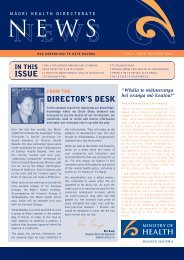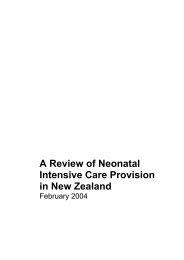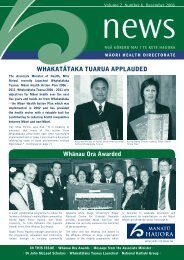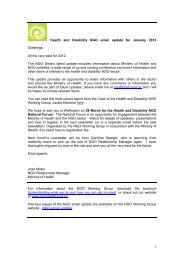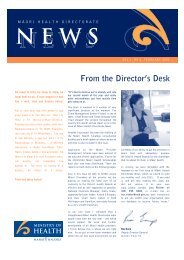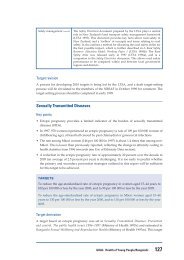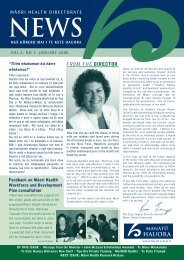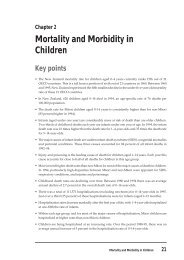breastscreen aotearoa an independent review - Ministry of Health
breastscreen aotearoa an independent review - Ministry of Health
breastscreen aotearoa an independent review - Ministry of Health
You also want an ePaper? Increase the reach of your titles
YUMPU automatically turns print PDFs into web optimized ePapers that Google loves.
testing system set up by the Royal Australasi<strong>an</strong> College <strong>of</strong> Radiologists, <strong>an</strong>d having tomeet a st<strong>an</strong>dard volume <strong>of</strong> reading at least 2000 screening mammograms each year.The verdict on each wom<strong>an</strong> is recorded <strong>independent</strong>ly by two radiologists, each <strong>of</strong>whom enters his/her recommendation for further action into the computerised recordsystem. If no abnormality is present the verdict is "routine recall" for repeat screeningin two years. If further imaging, clinical examination, or tissue diagnosis is requiredto diagnose a suspected abnormality the verdict is "refer for assessment", <strong>an</strong>dadditional descriptive details <strong>of</strong> the abnormality are also entered.Because it is recognised that interpreting mammograms is a difficult skill, a system <strong>of</strong>double reading by two radiologists, <strong>independent</strong>ly <strong>of</strong> each other, is observedthroughout BSA. If both agree on the verdict the appropriate action is taken. If theydisagree then further consultation is required. This differs between different LeadProviders, most referring the case to a third radiologist, but others relying ondiscussion <strong>of</strong> the films by the two radiologists to reach a consensus.6.4.1 Internal quality control for individual radiologists. The Clinical Directors<strong>of</strong> each Lead Provider have set up systems <strong>of</strong> ensuring that all radiologists workingin the Centre are able to compare their film reading with each other. Some <strong>of</strong> theClinical Directors arr<strong>an</strong>ge internal meetings to <strong>review</strong> films on a weekly basis, othersless frequently. The film <strong>review</strong>s focus particularly on <strong>an</strong>y interval c<strong>an</strong>cers that areknown, <strong>an</strong>d on the outcomes <strong>of</strong> cases referred to assessment. In addition each LeadProvider is paired with <strong>an</strong>other, <strong>an</strong>d every month each sends to its partner a set <strong>of</strong> tenfilms so that their interpretation c<strong>an</strong> be compared. At least one Lead Provider, BSHC,has set up a formal protocol for acting on <strong>an</strong>y disagreements but I am uncertainwhether this applies to all.The BSA Quality St<strong>an</strong>dards specify that a radiologists' meeting for the whole LeadProvider region should be held at least once every 3 months. But in two <strong>of</strong> the LeadProviders, (BSAN <strong>an</strong>d BSCC) I had the impression that they were not activelyinvolving radiologists in sub-contracted sites to participate in these exercises, while inothers there were obviously very close working relationships between main centre <strong>an</strong>dsub-contractors. The frequency <strong>of</strong> radiologists' film <strong>review</strong> meetings is audited everytwo years, but this may not be sufficient.6.4.2 Recommendation. The Clinical Directors <strong>of</strong> each Lead Provider shouldsubmit <strong>an</strong> <strong>an</strong>nual return to the National Screening Unit showing the number <strong>of</strong>film <strong>review</strong> meetings attended in the year by each radiologist, regardless <strong>of</strong>whether he/she works in the main centre or a sub-contracted site.6.5 Assessment <strong>of</strong> Women with Suspected Abnormality6.5.1 Appropriate care is taken in informing women that they need to return forassessment. In most cases it is the task <strong>of</strong> the Breast Care Nurse to telephone thewom<strong>an</strong>, while at the same time introducing herself <strong>an</strong>d reassuring the wom<strong>an</strong> that shewill be there to support her at the assessment clinic. The Breast Care Nurses whom Imet were dedicated to supporting women throughout the diagnostic process.19



